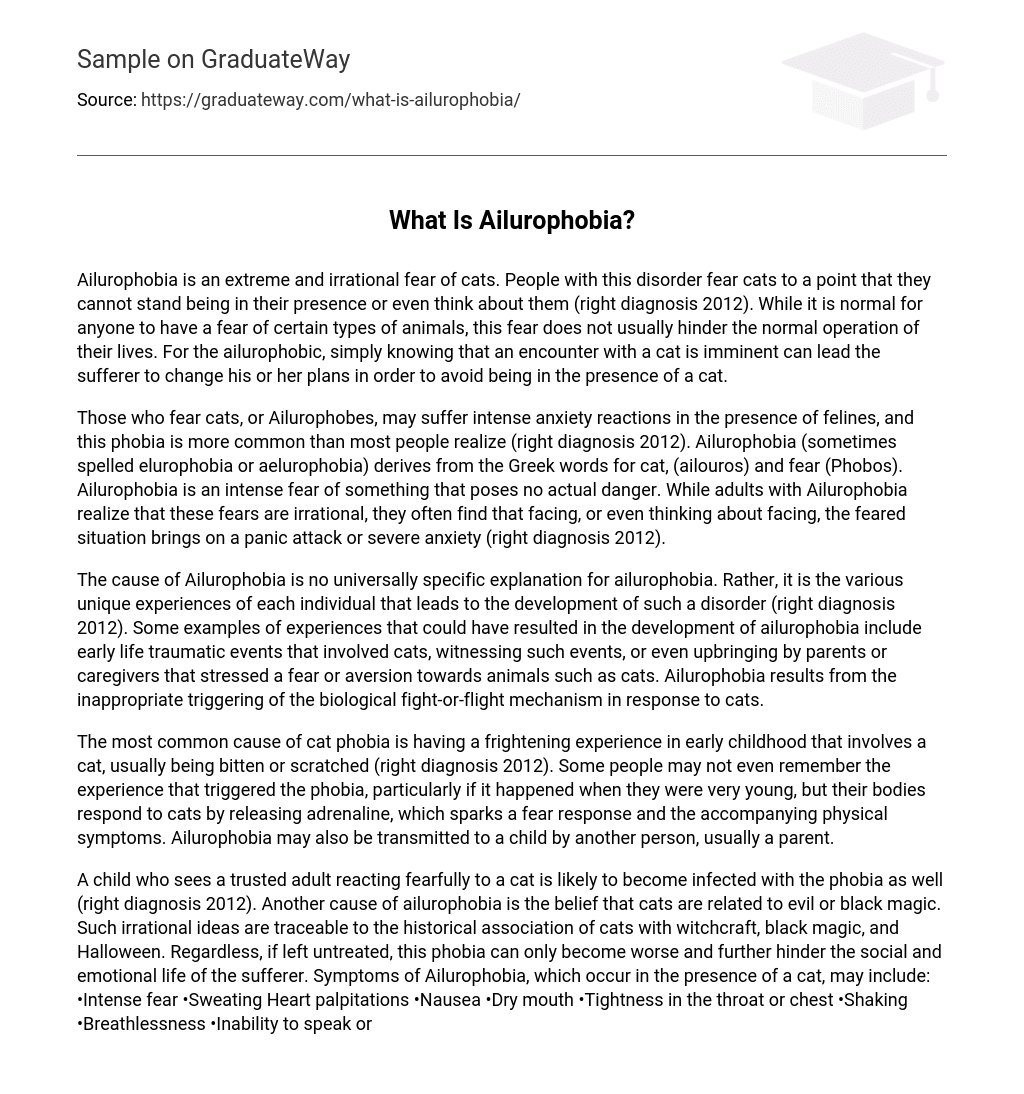Ailurophobia is an extreme and irrational fear of cats. People with this disorder fear cats to a point that they cannot stand being in their presence or even think about them (right diagnosis 2012). While it is normal for anyone to have a fear of certain types of animals, this fear does not usually hinder the normal operation of their lives. For the ailurophobic, simply knowing that an encounter with a cat is imminent can lead the sufferer to change his or her plans in order to avoid being in the presence of a cat.
Those who fear cats, or Ailurophobes, may suffer intense anxiety reactions in the presence of felines, and this phobia is more common than most people realize (right diagnosis 2012). Ailurophobia (sometimes spelled elurophobia or aelurophobia) derives from the Greek words for cat, (ailouros) and fear (Phobos). Ailurophobia is an intense fear of something that poses no actual danger. While adults with Ailurophobia realize that these fears are irrational, they often find that facing, or even thinking about facing, the feared situation brings on a panic attack or severe anxiety (right diagnosis 2012).
The cause of Ailurophobia is no universally specific explanation for ailurophobia. Rather, it is the various unique experiences of each individual that leads to the development of such a disorder (right diagnosis 2012). Some examples of experiences that could have resulted in the development of ailurophobia include early life traumatic events that involved cats, witnessing such events, or even upbringing by parents or caregivers that stressed a fear or aversion towards animals such as cats. Ailurophobia results from the inappropriate triggering of the biological fight-or-flight mechanism in response to cats.
The most common cause of cat phobia is having a frightening experience in early childhood that involves a cat, usually being bitten or scratched (right diagnosis 2012). Some people may not even remember the experience that triggered the phobia, particularly if it happened when they were very young, but their bodies respond to cats by releasing adrenaline, which sparks a fear response and the accompanying physical symptoms. Ailurophobia may also be transmitted to a child by another person, usually a parent.
A child who sees a trusted adult reacting fearfully to a cat is likely to become infected with the phobia as well (right diagnosis 2012). Another cause of ailurophobia is the belief that cats are related to evil or black magic. Such irrational ideas are traceable to the historical association of cats with witchcraft, black magic, and Halloween. Regardless, if left untreated, this phobia can only become worse and further hinder the social and emotional life of the sufferer. Symptoms of Ailurophobia, which occur in the presence of a cat, may include: •Intense fear •Sweating Heart palpitations •Nausea •Dry mouth •Tightness in the throat or chest •Shaking •Breathlessness •Inability to speak or think clearly An ailurophobe may also have negative beliefs about cats, viewing them as sadistic or sneaky. In extreme cases, the phobic individual will not even be able to leave the house for fear of encountering a cat, and even seeing a cat on television or in movie may induce anxiety symptoms (all about counseling 2012). Treatment for Ailurophobia like any other phobia, responds well to cognitive-behavioral therapy, and in some cases hypnotherapy as well.
Cognitive-behavioral therapy usually includes a desensitization component, which means gradual exposure to the thing that induces fear while in the presence of a supportive professional or trusted friend or family member (all about counseling 2012). Desensitization activities may include: •Looking at photos of cats •Watching videos about cats •Viewing a cat through a window •Being in the same room as a cat that is restrained on a leash or in a wire cage •And finally, being in a room with a free roaming cat
These activities may be combined with other strategies, such as practicing deep breathing to reduce physiological anxiety symptoms (all about counseling 2012). Reading books about cats is also beneficial, as it increases knowledge, which tends to decrease fear. Some people believe that the way to deal with fear is to orchestrate an intense, sudden exposure to the object of a phobia, an approach known as “flooding. ” Teasing or mockery others when they do confess their fears can worsen the phobia, so it’s important to only share it with those who can be relied upon to provide support and understanding.





